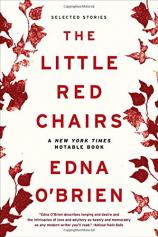The Little Red Chairs
Review
The Little Red Chairs
Although the Bosnian War of the early 1990s is now more than 20 years behind us, it is still in the news, with war criminal Radovan Karadžić convicted just this past week. But if you only have vague memories (or no memories at all) of this devastating conflict and the genocide it prompted, do yourself a favor and read up on it, at least briefly, before cracking open Edna O’Brien’s first novel in 10 years, THE LITTLE RED CHAIRS, which takes its name from a dramatic memorial to those killed in the conflict in Sarajevo.
The book is informed by the real-life story of Karadžić, a doctor and poet who became involved in politics and was eventually named president of the Bosnian Serb administration. In that role, he oversaw many atrocities, including the brutal Siege of Sarajevo, during which more than 5,000 civilians were killed, many of whom were buried in mass graves, their bodies never recovered. After the conflict, Karadžić went into deep hiding and was only discovered years after he had been living a very different kind of life.
"O’Brien is a masterful stylist, and her descriptions of the natural world, especially the countryside around Cloonoila, are striking in their precision and beauty..."
That’s where O’Brien’s talented pen picks up. In her novel, the fugitive has taken the name Dr. Vladimir Dragan, and when he arrives in the small Irish town of Cloonoila with his dramatic white beard and long hair, and with his air of mystery, he has no trouble establishing himself as a seer, healer and mystic. The women in town, in particular, grow fascinated with him, especially the town’s beauty, Fidelma. Fidelma has dreamed of having a child with her significantly older husband, Jack. After multiple pregnancies end in miscarriage, Jack seems to easily let go of the dream of having a family, but Fidelma can’t abandon her desire. Instead, she throws all her hopes on Vlad, a decision that will have lasting repercussions for Fidelma’s life, especially once Vlad’s true identity is unmasked.
O’Brien is a masterful stylist, and her descriptions of the natural world, especially the countryside around Cloonoila, are striking in their precision and beauty: “Once a month they drove to Strand Hill and sat on the bench facing the rocks that looked as if they would growl.” The lush descriptions of the natural world early in the novel contrast starkly with the more urban environment of the story’s second half, which is set largely in London, where Fidelma finds herself in exile.
And that brings us to the novel’s real subject. Although it is prompted by a single exile (Vlad) who brings about the exile of another (Fidelma), THE LITTLE RED CHAIRS is ultimately populated with a veritable chorus of voices of immigrants, many of them refugees and displaced persons from all over the globe, coming to Ireland and England in (a mostly futile) search of a better life. In two powerful chapters, O’Brien gives each of these minor characters, all of them near-invisible workers in the hospitality industry, a chance to tell their stories in brief but harrowing accounts, giving voice to the strange and often brutal circumstances that brought these disparate groups together against all odds.
Reviewed by Norah Piehl on April 1, 2016
The Little Red Chairs
- Publication Date: December 6, 2016
- Genres: Fiction
- Paperback: 320 pages
- Publisher: Back Bay Books
- ISBN-10: 0316378240
- ISBN-13: 9780316378246





